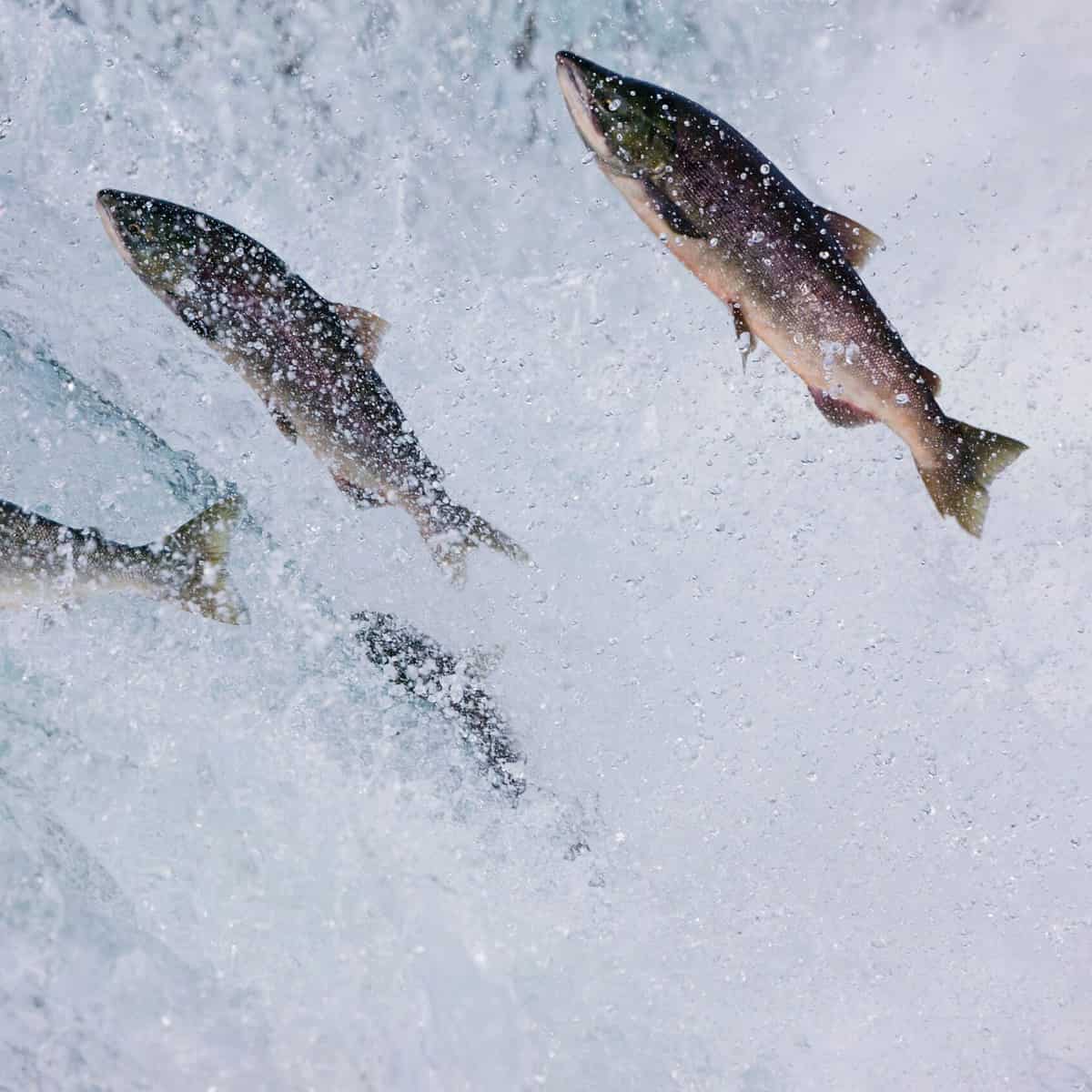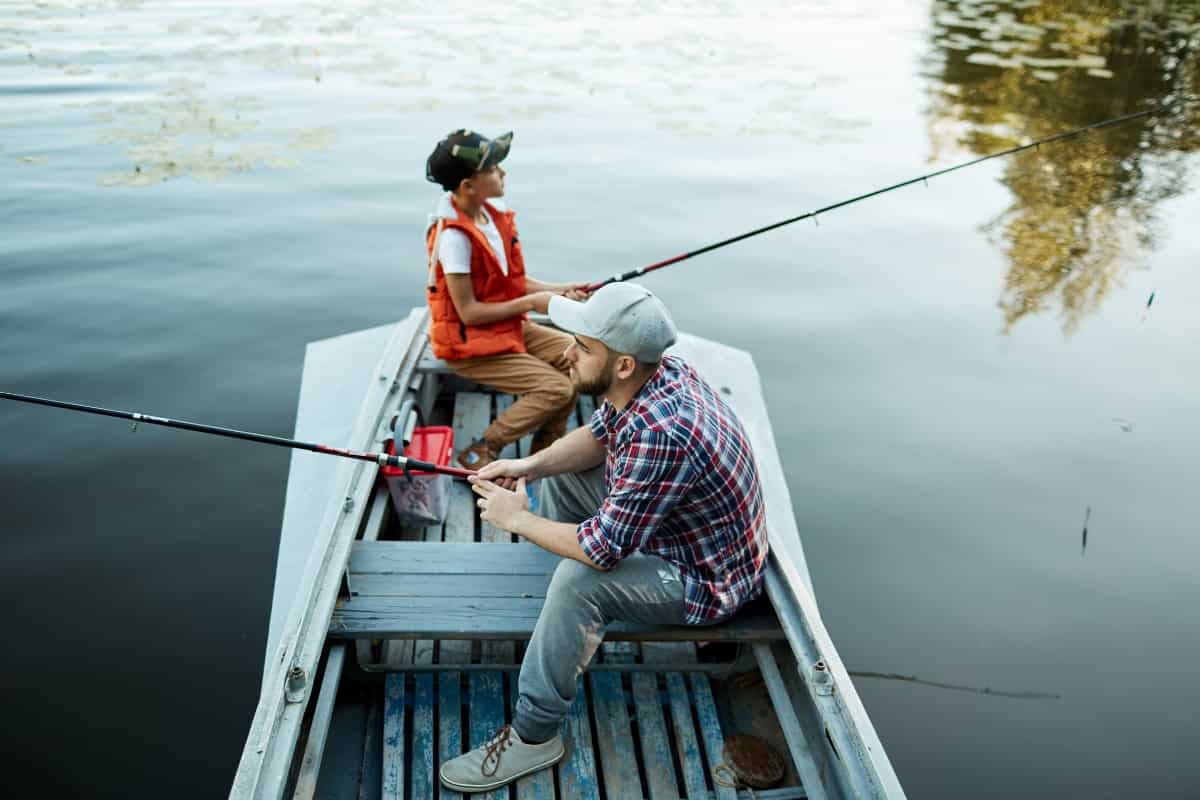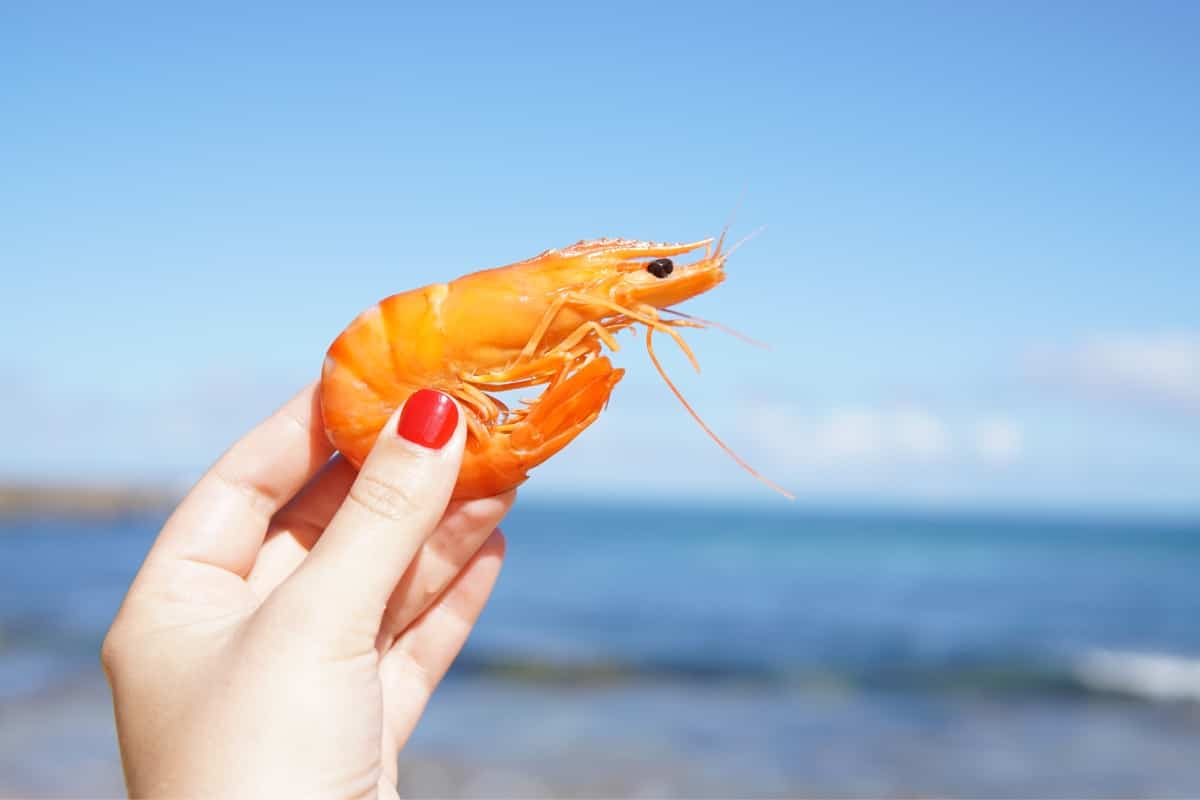Catching golden trout on a trout fishing trip is probably one of the most relaxing yet exciting fishing trips an angler can go on.
Especially if you’re going for golden trout.
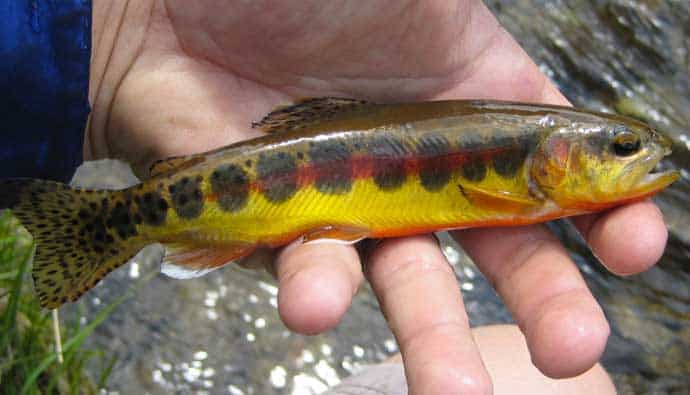
The golden trout, also known as the California Golden Trout, is native to Golden Trout Creek, Volcano Creek, and the South Fork Kern River. It’s the state fish of California.
Be sure to check out our full guide on Trout Fishing Tips.
These golden trout are closely related to two other rainbow trout subspecies. The Little Kern golden trout, found in the Little Kern River basin, and the Kern River rainbow trout, found in the Kern River system, are sometimes referred to as the “golden trout complex.”
The golden trout can reach sizes up 11 pounds. This hard-fighting fish is a rush to catch. In this article, I am going to show you how to do just that.
I will cover several tips, as well as the difference between golden trout and other trout species.
So let’s go golden trout fishing!
What Are Golden Trout?
Originally golden trout were described as a subspecies of the salmon species, with the name Salmo mykiss aguabonita. Golden trout is still often considered a subspecies. (Now called Oncorhynchus Mykiss Aguabonita) along with several other rainbow trout subspecies.
These are commonly known as redband trout. FishBase and the Catalog of Fishes now list O. aguabonita as an independent species rather than as subspecies of O. mykiss.
The golden trout has golden flanks with red horizontal bands along the lateral lines on each side. They also have about 10 dark, vertical, oval marks (called “parr marks”) on each side.
Dorsal, lateral, and anal fins have white leading edges. In their native habitat, adults range from 6 to 12 inches long.
Golden trout over 12 inches are considered large.
These golden trout have been transplanted to lakes and have been recorded up to 11 pounds.
Golden Trout Like High Elevations
The golden trout is commonly found at elevations from 6,890 feet (2,100 m) to 10,000 feet (3,000 m) above sea level. These fish are native only to California’s southern Sierra Nevada mountains. Outside of its native range in California, they are more often found in cirques and creeks in wilderness areas around 10,500–12,000.”
Their preferred water temperature is 58 to 62 degrees Fahrenheit. But they can tolerate temperatures in degraded streams on the Kern Plateau as high as 70 degrees Fahrenheit. So long as those waters cool during the night.
The only other species of fish indigenous to the native range of California golden trout is the Sacramento sucker.
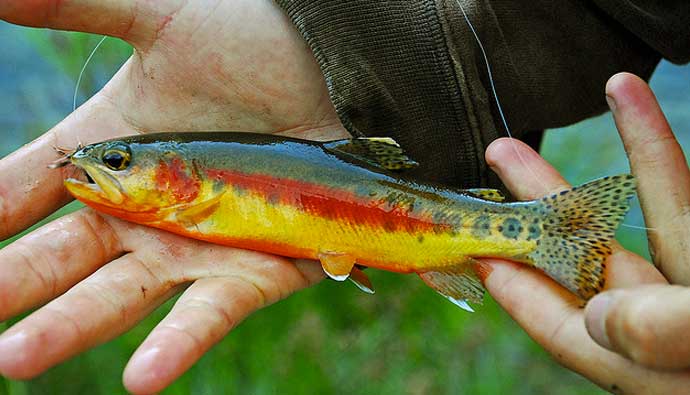
Golden Trout are Threatened
Years of overexploitation, mismanagement and competition with exotic species have brought golden trout to the brink of being designated as threatened.
Introduced brook trout out-compete them for food. Introduced brown trout prey on them, and introduced rainbow trout hybridize with them, damaging the native gene pool.
Populations have been in steady decline for decades.
How to Fish for Golden Trout
Fly fishermen and other anglers have to match their lures to the types of food items available at the high altitudes where they occur.
Caddisflies and midges are the most effective. Though many have been caught with spoons, spinners, worms, and salmon eggs. As well as small crustaceans and various small insects. The following are fishing methods used to catch them:
- Baitcasting
- Fly fishing
- Spin casting
- Trolling
- Drift fishing
- Jigging
The following are lures, tackle, and bait that make good choices:
- Cured fish roe
- Jigs
- Spinnerbaits
- Flies
- Spoons
Where To Catch Golden Trout
The golden trout is native only to the upper Kern River basin in Tulare and Kern Counties, California. The golden trout are usually found in clear, cool waters at elevations higher than 6,890 ft.
Despite its limited distribution, there are two recognized subspecies of golden trout. Oncorhynchus aguabonita, which is confined to the south fork of the Kern River. Golden Trout Creek and Oncorhynchus Aguabonita Gilberti, which is confined to the Main Kern and Little Kern Rivers.
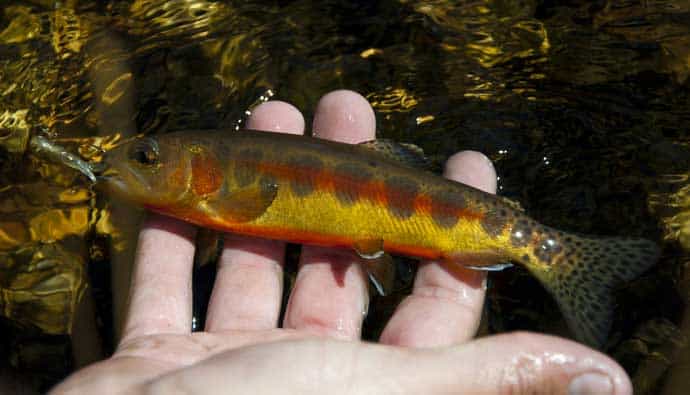
An area of warm water where the South Fork joins the Kern apparently serves as a natural barrier that keeps the two subspecies apart. They have been introduced to other areas. These include the states of Washington, Idaho, and Wyoming, which have self-sustaining populations.
It is believed that most of these populations have hybridized with cutthroat trout. According to some fisheries scientists, most trout in the Kern River basin are also hybrids of recent origin. The only pure populations of golden trout are those limited to the headwater areas.
The following list includes additional areas to catch golden trout:
- Backflow
- Dams and falls
- Eddies
- Holes
- Merging currents
- Outside of bends
- Rock and boulder pockets
- Standing waves
- Current edges
- Drop-offs
- Freshwater lakes and ponds
- Inlets and outlets
- Open water
- Rivers and streams
- Small pointed waves
- Undercuts
What Are the Differences Between Golden Trout and Other Trout?
Oncorhynchus aguabonita is rare and elusive. They inhabit some of the most remote lakes in the United States.
These trout have a very limited range, as they are only found in high alpine lakes and streams found in the Rocky Mountains and the Cascades. Because of this, reaching good trout waters is no easy task, usually requiring a long hike or even horse pack in.
Additionally, due to the environment in which they live (very cold, low nutrient water). This trout is generally quite small as there is not enough food to support larger trout.
They are Particular Eaters
Despite the relatively low fishing pressure they receive, this trout can be somewhat difficult to catch. They tend to be particular about what they eat. Another consideration is not all high alpine lakes, and rivers contain these trout.
Simply locating waters that have good golden trout populations can be an effort in and of itself. Since these trout live in the most beautiful scenery in the United States, a day spent looking for or fishing for golden trout can never be wasted.
It’s About the Journey, Not Always the Catch
Even if you don’t catch any, for an angler looking to catch trout in a splendid and scenic environment, chasing this trout is the way to go. It is hard to miss an Oncorhynchus aguabonita, as their name conveys.
These beautiful trout are golden in color, so they are hard to mistake for other types of fish. The Oncorhynchus aguabonita also has a scattering of black spots and a red striping along with its lateral line, belly, and gill plates.
Since these trout are not very common, it is recommended that anglers who catch golden trout release them instead of eating them. If you are looking for a fish you can eat, try some brook trout instead.
Brook trout are usually found in the same waters as Oncorhynchus aguabonita are, but are not nearly as rare. Most agree they taste better too.
Frequently Asked Questions
The San Joaquin Delta, running throughout California, seems to be the most popular.
The general limit is 5 per day and never more than 10 in possession.
Golden Trout.
Rainbow trout, with the record in 2009 being 20 pounds.
Clark Fork River
Blackfoot River
Bitterroot River
Rock Creek
Missouri River
Gallatin River
Madison River
Big Hole River
The Delta
The McCloud River
Clear Lake
Lake Shasta
Santa Monica Pier
Lake Almanor
Lake Cuyamaca
Castaic Lake
On average, 6-7 pounds, with some growing as large as 20 pounds, depending on the species.
Insider Advice
This trout is truly a beautiful and unique species of trout. They are a lot of fun to catch, and getting to them, in many cases, is half the battle.
This trout is one of the more native fish species to California, yet it is also the most threatened.
If you decide to fish for this trout, it is highly recommended to practice catch and release. With proper conservation and catch and release by anglers, it is hopeful and possible for the numbers to begin to rise.
This trout can live up to nine years old, but six-seven years is more common. This limits the number of times the golden trout can successfully spawn. This also adds to their rapidly declining numbers.
These are beautiful species of trout we all want to see around for generations to come. Enjoy catching them but practice safe catch and release to give them a chance to still be here for generations to come.

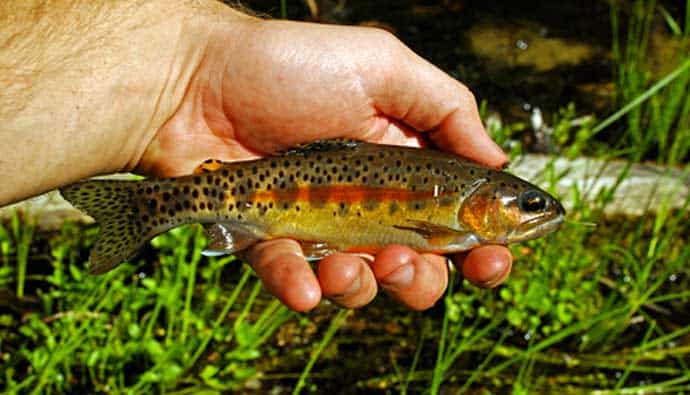



 Facebook
Facebook YouTube
YouTube
